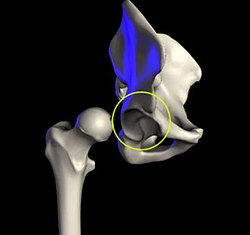Acetabular
| Acetabulum of pelvis | |
|---|---|

Pelvic girdle
|
|

The acetabulum
|
|
| Details | |
| Identifiers | |
| Latin | Acetabulum |
| MeSH | A02.835.232.611.108 |
| Dorlands /Elsevier |
a_06/12104853 |
| TA | A02.5.01.002 |
| FMA | 16579 |
|
Anatomical terms of bone
[]
|
|
The acetabulum /æsəˈtæbjʊləm/ (cotyloid cavity) is a surface of the pelvis. The head of the femur meets with the pelvis at the acetabulum, forming the hip joint.
There are three bones of the os coxae (hip bone) that come together to form the acetabulum. Contributing a little more than two-fifths of the structure is the ischium, which provides lower and side boundaries to the acetabulum. The ilium forms the upper boundary, providing a little less than two-fifths of the structure of the acetabulum. The rest is formed by the pubis, near the midline.
It is bounded by a prominent uneven rim, which is thick and strong above, and serves for the attachment of the acetabular labrum, which reduces its opening, and deepens the surface for formation of the hip joint. At the lower part of the acetabulum is the acetabular notch, which is continuous with a circular depression, the acetabular fossa, at the bottom of the cavity of the acetabulum. The rest of the acetabulum is formed by a curved, crescent-moon shaped surface, the lunate surface, where the joint is made with the head of the femur. Its counterpart in the pectoral girdle is the glenoid fossa.
The acetabulum is also home to the acetabular fossa, an attachment site for the ligamentum teres, a triangular, somewhat flattened band implanted by its apex into the antero-superior part of the fovea capitis femoris. The notch is converted into a foramen by the transverse acetabular ligament; through the foramen nutrient vessels and nerves enter the joint. This is what holds the head of the femur securely in the acetabulum.
...
Wikipedia
